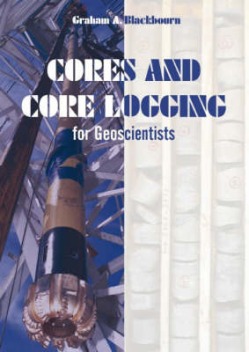Cores and Core Logging for Geoscientists (2nd Edition)
Graham A Blackbourn
Published by: Whittles Publishing
Publication date: 2009
ISBN: 978-1904445-39-5 (in USA: 978-1-4398-0116-1)
List price: £37.50
164 pp
www.whittlespublishing.com

Many will welcome this updated edition of a well known and well used favourite, first published 20 years ago under the title 'Cores and Core Logging for Geologists'. The slight change of emphasis to ‘Geoscientists’ is presumably intended to reflect the broadening of geological training and application that has occurred in the intervening two decades.
Even a brief perusal of this short book suggests that it will be a valuable addition to the library of any practising geologist or geoscientist. It is nicely constructed, printed on good quality paper, well illustrated by diagrams and photographs - including an excellent 12-page colour section - and supported by three useful appendices, a short bibliography and an effective index. It is a practical manual for the taking and logging of rock cores, mainly for use in geological exploration and geotechnical investigation, and I would expect users, especially new practitioners, to come to regard it as a valued companion.
Dr Graham Blackbourn is well positioned to present this focused guidance, having spent nearly 10 years with a major oil company prior to publishing the first edition of this book, and then establishing his own consultancy based near Edinburgh. He is recognised for specialist expertise in petrography and reservoir quality, and for technical publications on marine clastics, continental 'red bed' facies and diagenesis in clastic reservoirs. But this has not detracted from his ability to engage to a high standard with the basic mechanics and disciplines of taking and logging rock cores that are suitable for a range of end uses.
As the title makes clear, this book is intended for experienced geoscientists and geologists, and does not waste space discussing geological principles that should be known to the user. Dr Blackbourn is correct, in his Preface, to note that newly-trained geologists will rarely have encountered rock cores in their studies, in any sort of serious sense, yet many start their professional careers by being immediately confronted with the task of logging seemingly endless metres of such cores, with much possibly hanging on the reliability of their record. I recently witnessed the embarrassment of a consultant geologist in court, who had misguidedly relied on ex-quarry core logs prepared by a novice, describing a complex bedded sequence of mudstones, calcareous mudstones, occasional limestone and seams of shale as being wholly and simply 'limestone'. The value of this manual is that it builds on a basic geological training and provides clear guidance on the whole process of taking cores and then subjecting them to logging, testing, interpretation and storage.
There are seven chapters, starting with an admirably concise two-page Introduction. Chapter 2 (25 pages) gives an up-to-date review of drilling and coring methods, while Chapter 3 (23 pages) provides thorough guidance on core handling. The core of the book, so to speak, is Chapter 4 (42 pages) on core logging, which represents an excellent and beautifully illustrated step-by-step methodology for the preparation of 'preliminary logs'. Options for core analysis and testing are described, non-prescriptively, in Chapter 5 (20 pages), which importantly includes limitations. Chapter 6 (14 pages) tackles interpretation and preparation of final logs, but this should not be misunderstood; some 'interpretation' of factual observations is often desirable in preparing a 'final log', which can be produced from the preliminary log for presentation purposes. The book does not go beyond its brief in terms of interpretation - oil geologists, engineering geologists and others will need to apply their specialist knowledge and skills in interpreting the overall meaning and implications of core logging data produced on the basis of this manual. Chapter 7 (seven pages) closes the book by providing guidance on core preservation and storage.
Overall, this is an impressive little book that presents practical, sensible guidance on an important topic for several branches of applied geoscience – all based on actual rather than academic experience. I have no hesitation in recommending its purchase to all geologists and geoscientists, but most especially to those who are just starting their professional careers, for whom the book will long remain a trusted companion.
Dr Ian Sims
RSK STATS Limited, Hemel Hempstead